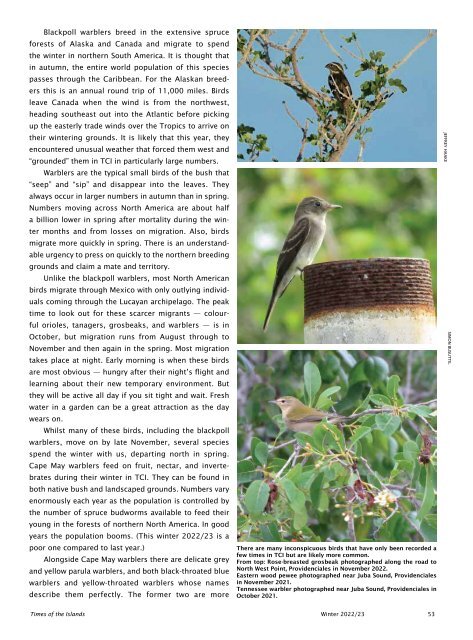Times of the Islands Winter 2022/23
Presents the "soul of the Turks & Caicos Islands" with in-depth features about local people, culture, history, environment, real estate, businesses, resorts, restaurants and activities.
Presents the "soul of the Turks & Caicos Islands" with in-depth features about local people, culture, history, environment, real estate, businesses, resorts, restaurants and activities.
- No tags were found...
You also want an ePaper? Increase the reach of your titles
YUMPU automatically turns print PDFs into web optimized ePapers that Google loves.
Blackpoll warblers breed in <strong>the</strong> extensive spruce<br />
forests <strong>of</strong> Alaska and Canada and migrate to spend<br />
<strong>the</strong> winter in nor<strong>the</strong>rn South America. It is thought that<br />
in autumn, <strong>the</strong> entire world population <strong>of</strong> this species<br />
passes through <strong>the</strong> Caribbean. For <strong>the</strong> Alaskan breeders<br />
this is an annual round trip <strong>of</strong> 11,000 miles. Birds<br />
leave Canada when <strong>the</strong> wind is from <strong>the</strong> northwest,<br />
heading sou<strong>the</strong>ast out into <strong>the</strong> Atlantic before picking<br />
up <strong>the</strong> easterly trade winds over <strong>the</strong> Tropics to arrive on<br />
<strong>the</strong>ir wintering grounds. It is likely that this year, <strong>the</strong>y<br />
encountered unusual wea<strong>the</strong>r that forced <strong>the</strong>m west and<br />
“grounded” <strong>the</strong>m in TCI in particularly large numbers.<br />
Warblers are <strong>the</strong> typical small birds <strong>of</strong> <strong>the</strong> bush that<br />
“seep” and “sip” and disappear into <strong>the</strong> leaves. They<br />
always occur in larger numbers in autumn than in spring.<br />
Numbers moving across North America are about half<br />
a billion lower in spring after mortality during <strong>the</strong> winter<br />
months and from losses on migration. Also, birds<br />
migrate more quickly in spring. There is an understandable<br />
urgency to press on quickly to <strong>the</strong> nor<strong>the</strong>rn breeding<br />
grounds and claim a mate and territory.<br />
Unlike <strong>the</strong> blackpoll warblers, most North American<br />
birds migrate through Mexico with only outlying individuals<br />
coming through <strong>the</strong> Lucayan archipelago. The peak<br />
time to look out for <strong>the</strong>se scarcer migrants — colourful<br />
orioles, tanagers, grosbeaks, and warblers — is in<br />
October, but migration runs from August through to<br />
November and <strong>the</strong>n again in <strong>the</strong> spring. Most migration<br />
takes place at night. Early morning is when <strong>the</strong>se birds<br />
are most obvious — hungry after <strong>the</strong>ir night’s flight and<br />
learning about <strong>the</strong>ir new temporary environment. But<br />
<strong>the</strong>y will be active all day if you sit tight and wait. Fresh<br />
water in a garden can be a great attraction as <strong>the</strong> day<br />
wears on.<br />
Whilst many <strong>of</strong> <strong>the</strong>se birds, including <strong>the</strong> blackpoll<br />
warblers, move on by late November, several species<br />
spend <strong>the</strong> winter with us, departing north in spring.<br />
Cape May warblers feed on fruit, nectar, and invertebrates<br />
during <strong>the</strong>ir winter in TCI. They can be found in<br />
both native bush and landscaped grounds. Numbers vary<br />
enormously each year as <strong>the</strong> population is controlled by<br />
<strong>the</strong> number <strong>of</strong> spruce budworms available to feed <strong>the</strong>ir<br />
young in <strong>the</strong> forests <strong>of</strong> nor<strong>the</strong>rn North America. In good<br />
years <strong>the</strong> population booms. (This winter <strong>2022</strong>/<strong>23</strong> is a<br />
poor one compared to last year.)<br />
Alongside Cape May warblers <strong>the</strong>re are delicate grey<br />
and yellow parula warblers, and both black-throated blue<br />
warblers and yellow-throated warblers whose names<br />
describe <strong>the</strong>m perfectly. The former two are more<br />
There are many inconspicuous birds that have only been recorded a<br />
few times in TCI but are likely more common.<br />
From top: Rose-breasted grosbeak photographed along <strong>the</strong> road to<br />
North West Point, Providenciales in November <strong>2022</strong>.<br />
Eastern wood pewee photographed near Juba Sound, Providenciales<br />
in November 2021.<br />
Tennessee warbler photographed near Juba Sound, Providenciales in<br />
October 2021.<br />
JEFFREY HAAKE<br />
SIMON BUSUTTIL<br />
<strong>Times</strong> <strong>of</strong> <strong>the</strong> <strong>Islands</strong> <strong>Winter</strong> <strong>2022</strong>/<strong>23</strong> 53
















